JAXA Astronaut Activity Report, July, 2015
Last Updated: September 30, 2015
This is JAXA’s Japanese astronaut activity report for July, 2015.
Astronaut Kimiya Yui commences his ISS Expedition mission
In early July, Astronaut Kimiya Yui and his crewmates Oleg Kononenko of the Russian Space Agency (RSA) and Kjell Lindgren of NASA underwent final training at the Gagarin Cosmonaut Training Center (GCTC).
On July 8 (local time), the trio was officially certified as the 43S prime crew, and held a press conference on the same day. Afterwards, as part of traditional preflight events, they visited the vicinity that is linked to the history of Russian space development, featuring a museum in Star City and a statue of Yuri Gagarin.
On July 11 (local time), the crew moved to Baikonur, Kazakhstan, the launch site of the Soyuz spacecraft.
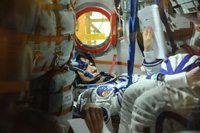
Yui checking the Soyuz TMA-17M spacecraft (43S) at the Baikonur Cosmodrome (Credit: S.P.Korolev RSC Energia)
Launch of the Soyuz TMA-17M spacecraft (Credit: JAXA/NASA/Aubrey Gemignani)
Final preparations in Baikonur covered inspection of the actual Soyuz TMA-17M spacecraft, a dress rehearsal that included checking Yui’s Sokol spacesuit for leaks and fit-checking with the seat liner, training on manual Soyuz operations, a medical checkup, and observing assembly of the Soyuz rocket.
Finally on July 23, the trio was launched aboard the Soyuz TMA-17M (43S) spacecraft from the Baikonur Cosmodrome. Approximately six hours later, 43S docked with the International Space Station (ISS) and the trio commenced their long-duration mission.
For Yui’s launch, Astronaut Koichi Wakata had traveled to Baikonur in support of Yui’s family.
Yui is now conducting various experiments and performing system maintenance enthusiastically on the ISS.
Astronaut Norishige Kanai participates in NEEMO 20
For two weeks from July 20, Astronaut Norishige Kanai underwent the 20th NASA Extreme Environment Mission Operations (NEEMO 20).
NEEMO 20 was conducted in an underwater laboratory with a habitable area called Aquarius, located off the Florida Keys at a depth of about 20 meters. NEEMO aims to foster the behavioral capabilities of participants when working as a team, such as teamworking, leadership, self-management, and cross-cultural understanding in an isolated environment, and prepare for a long-duration stay on the ISS.
Pre-training was held nearby the site since July 13, a week prior to the start of NEEMO.
On July 20, Kanai and the participants—Astronauts Luca Parmitano of the European Space Agency (ESA) and Serena Aunon of NASA, and NASA EVA Management Office engineer David Coan—commenced their stay in Aquarius. Although fostering teamwork ability had been targeted during NEEMO 20, technical tests and assessments toward future manned space exploration were also conducted. In the submarine outside the laboratory, Extravehicular Activities (EVA) on asteroids and Mars were simulated to verify the usability of sample collection tools and work methods, depending on different surfaces and gravity levels.
Tests were also conducted to determine whether members could perform work by wearing an eyeglass-type device that displayed the work procedures, as well as whether work could be done well under communication time delays with the controllers. At a press conference held from Aquarius, Kanai explained the content and status of his training to the media.
Astronaut Takuya Onishi continues training for the ISS long-duration stay
Continuing from June, Astronaut Takuya Onishi, a crew member for the Expedition 48/49 mission to the International Space Station (ISS), continued training at the NASA Johnson Space Center (JSC).
At the JSC, Onishi took a simulation exam on responses in the event of emergencies on the ISS. Onishi demonstrated responses to such emergencies as fire, sudden depressurization, and toxic spills in completing the exam. He then completed all other exams as an Operator of the systems in the ISS U.S. segment.
From July 6, Onishi stayed in Japan for three weeks.
During his stay, while undergoing training for the Japanese Experiment Module (“Kibo”), Onishi participated in various activities, such as attending meetings for his long-duration mission, making courtesy visits to related parties, and engaging in public relations activities.
Training for Kibo started with a review of the knowledge and techniques that he had learned in the previous training series, followed by training on the systems and experiments in Kibo, mainly on Kibo’s Airlock.
Training on the Airlock was to install the JEM Small Satellite Orbital Deployer (J-SSOD) to Kibo’s Airlock. During the simulation of CubeSat (small satellite) deployment operations alongside the JAXA Flight Control Team (JFCT), Onishi confirmed collaboration with the team in case any irregularities occur.
Onishi also gained an overview of the Exposed Experiment Handrail Attachment Mechanism (ExHAM), an exposed experiment device attached to Kibo’s Exposed Facility (EF) where experiments have been underway since May.
Other training included daily operations conducted on Kibo, as well as service and maintenance operations.
Astronaut Koichi Wakata participates in HTV5 operations simulation as CAPCOM
From July 9-10 (Japan time), the Flight Control Team (FCT) of the H-II Transfer Vehicle (HTV) KOUNOTORI and the NASA ISS flight controllers engaged in joint simulation training.
Astronaut Koichi Wakata participated in the simulation training as a member of the NASA flight controllers.
They simulated a series of operations ranging from KOUNOTORI’s rendezvous with the ISS, capture by the Space Station Remote Manipulator System (SSRMS), and berthing with the ISS, to activation.
Wakata will serve as the lead Capsule Communicator (CAPCOM: ground communicator with the ISS) to support onboard astronauts who maneuver the SSRMS during KOUNOTORI 5 capture operation. While on orbit, Astronaut Yui will maneuver the SSRMS to grapple KOUNOTORI 5, and Astronaut Wakata will support SSRMS operations from the ground.
The simulation held at the TKSC was open to the press. Mayumi Matsuura, lead HTV5 Flight Director (FD), was joined by Onishi to explain the content of the simulation training. Recalling his experience serving as one of the CAPCOMs during the HTV4 mission, Onishi gave the press his personal insights on the training.
This entry passed through the Full-Text RSS service – if this is your content and you’re reading it on someone else’s site, please read the FAQ at fivefilters.org/content-only/faq.php#publishers.
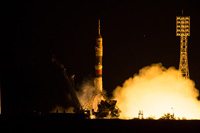
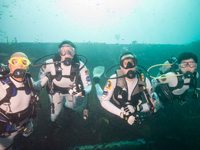
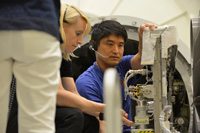
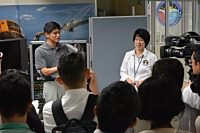
Comments are closed.